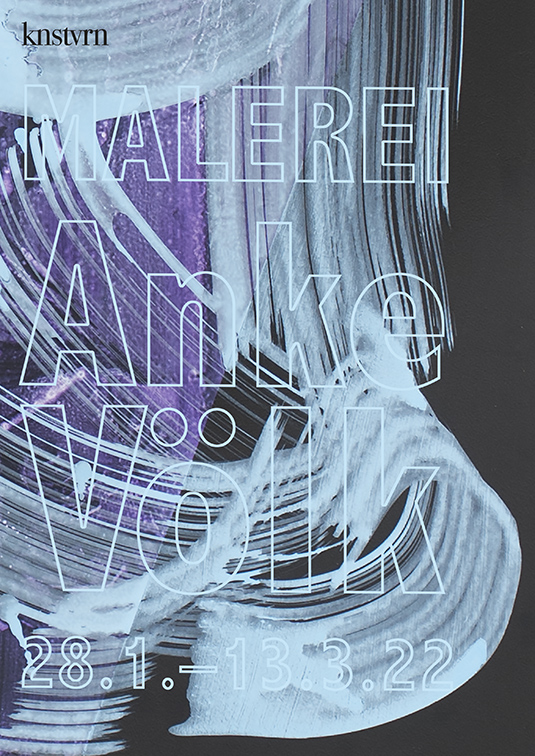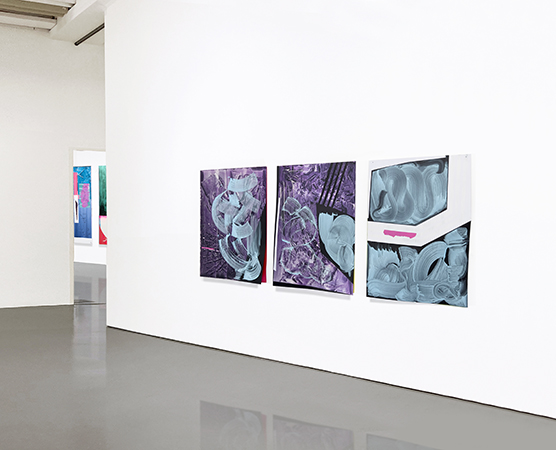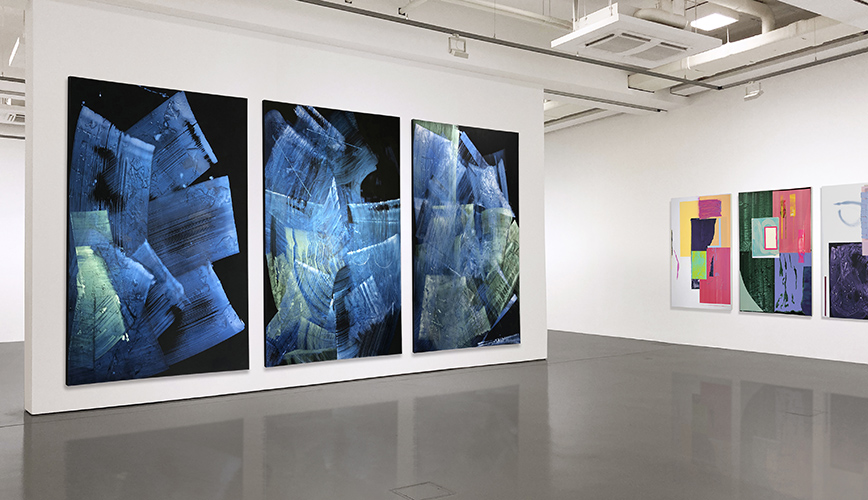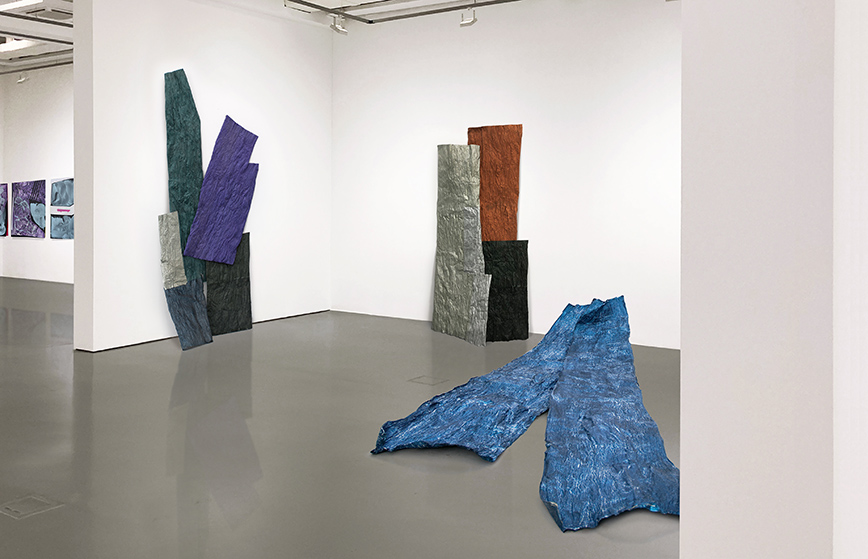*1965 Idar-Oberstein
1993–2000 Studium Malerei in Basel, Karlsruhe und Wien. Einzelausstellungen u.a.:
Städtische Galerie, Waldkraiburg; Drawing Room, Hamburg; Kienzle Art Foundation, Berlin;
Salon Plastique, Berlin; Lage Egal, Berlin; bcma Galerie, Berlin.
Gruppenausstellungen u.a.: Ancient & Modern, London; Galerie Krobath, Wien; Kunstbunker
Nürnberg; Galleri Kant, Kopenhagen; Alfa Gallery, Miami; paper positions, Basel; Kunstverein,
Schwäbisch Hall; Lage Egal, Berlin; Institut Française, Bologna; Sies + Höke, Düsseldorf.
Völk ist Mitgründerin des Berliner Ausstellungsprojekts „L’oiseau prèsente“ (2010).
Sie lebt und arbeitet in Berlin.
1993-2000 studied painting in Basel, Karlsruhe and Vienna. Solo exhibitions a.o.:
Städtische Galerie, Waldkraiburg; Drawing Room, Hamburg; Kienzle Art Foundation, Berlin;
Salon Plastique, Berlin; Lage Egal, Berlin; bcma Galerie, Berlin.
Group exhibitions a.o.: Ancient & Modern, London; Galerie Krobath, Vienna; Kunstbunker
Nürnberg; Galleri Kant, Copenhagen; Alfa Gallery, Miami; paper positions, Basel; Kunstverein,
Schwäbisch Hall; Lage Egal, Berlin; Institut Française, Bologna; Sies + Höke, Düsseldorf.
Völk is co-founder of the Berlin exhibition project „L‘oiseau prèsente“ (2010).
She lives and works in Berlin.
MALEREI
„Die Arbeiten haben für mich verschiedene Aufgaben und Funktionen. Die können auch innerhalb
meines Systems wechseln, sind dabei nicht hierarchisch. Ich bewege mich ja in einem abstrakten Feld,
und innerhalb diesem bleibt dieses System, eine Anlehnung an den sprachlichen Bereich von Syntax und
Semantik, auch abstrakt. Die Bezüge und Strukturen meines Denkens in Bildern haben eine gewisse
körperliche Erscheinung im Gesamtbildraum. Nicht nur mit Malerei in den Raum gehen, sondern auch
den Raum als dreidimensionales Bild begreifen.“
Anke Völk
MALEREI
„The works have different tasks and functions for me. They can also change within my system, but
they are not hierarchical. I move in an abstract field, and within this field this system, a
reference to the linguistic field of syntax and semantics, also remains abstract. In the overall
pictorial space, the references and structures of my thinking in paintings have a certain physical
appearance. Not only going into space with painting, but also understanding space as a
three-dimensional painting itself.“
Anke Völk






MALEREI
auf Digitaldruck, Wand und Aluminium, auf Papier, Leinwand und papiernen
Objekten – in ihrer Ausstellung im knstvrn zeigt Anke Völk Arbeiten, die vor allem auch
dem Bildträger Raum geben.
Völk ist die Verbindung von Produktions- und Ausstellungsort wichtig. Für die 2022 für
den knstvrn entwickelte Wandarbeit „Mural“, ein „paintrint“ aus abstrakter Malerei auf
Papier und Digitaldruck an der Wand, kombiniert sie gezoomt wirkende Strukturen mit
fotografischen Fragmenten Ihres Ateliers in Berlin und Details des Außen- und Innenraums
des knstvrn.
Seit vielen Jahren entwickelt Völk ihre Murals: Malerei und metallisch glänzende Oberflächen
bilden eine Basis, ergänzende Bildelemente und Materialitäten suchen den
Bezug zum Raum der jeweiligen Architektur. Wand wie Raum als Bildträger transportieren
das performative Moment der kraftvollen Malerei wie das Temporäre des Murals.
Unweigerlich ist man an Collagen erinnert, sind ergänzte Bildelemente des Murals
doch auch Leinwände oder Papierarbeiten. Es geht Völk eben um den Versuch, etwas
neu zu ordnen, neu zu gewichten.
Drei Wandarbeiten doppelter Aluminiumplatten verweigern sich der Ebene. Die obere
Platte aufgebogen, aufgeblättert in den Raum, gibt den Blick auf das Dahinter, auf den
Träger der Malerei preis und stellt die Frage nach der Souveränität der Farbe.
Aus tief mattem, in vielen Schichten bearbeitetem Schwarz, heben sich auf drei großformatigen
Arbeiten breite, metallisch glänzende Pinselbahnen ab, die Völks Duktus
zur malerischen Geste verdichten. Die Farbe selbst wirkt wie erstarrte Substanz, erstarrte
Bewegung und zeigt doch Völks „bewegt sein“ auf andere Art, opulent wie pur,
vielschichtig und auch direkt.
MALEREI
on digital print, wall and aluminium, on paper, canvas and paper objects – in
her exhibition at knstvrn, Anke Völk shows works that above all also give space to the
image carrier.
For Völk, the connection between production and exhibition space is important. For
the wall piece „Mural“ developed for knstvrn in 2022, a „paintrint“ of abstract painting
on paper and digital printing on the wall, she combines zoomed-in structures with
photographic fragments of her studio in Berlin and details of the exterior and interior of
the knstvrn.
Völk has been developing her murals for many years: painting and shiny metallic surfaces
form a basis, complementary pictorial elements and materialities seek a reference to
the space of the respective architecture. Wall and space as image carrier transport the
performative moment of the powerful painting as well as the temporary nature of the
mural. The viewer is reminded of collages, since the supplementary pictorial elements
of the murals are also canvases or works on paper. The point of Völk‘s work is to try to
rearrange something, to give it a new weighting.
Three wall works of double aluminium plates refuse to be flat. The upper plate is bent
up, opened up into the room, revealing the view of what lies behind, of the carrier of
the painting, and poses the question of the sovereignty of colour.
In three large-format works, broad, shiny metallic brushstrokes stand out from the
deep, matt black worked in many layers, condensing Völk‘s ductus into a painterly
gesture. The paint itself seems like frozen substance, frozen movement and yet shows
Völk‘s „being moved“ in a different way, opulent as well as pure, multi-layered and also
direct.


Ein Oktett mittelgroßer weiß grundierter Arbeiten stellt eine sich überlagernde und
durchdringende Gruppe von Farbblöcken mit rissigen, schrammigen Strukturen vor,
die unweigerlich eine Assoziation von schnell wechselnden Farbfeldern erzeugt, die
die Dynamik in Völks Bildwelt zeigt. Bestehende Arbeiten Völks sind als Siebdruck
eingearbeitet, bilden komprimierte Anordnungen von Fragmenten, wie Buchstaben
auf der Suche nach ihrem speziellen Begriff.
So verhalten sich ihre „MalereiGruppen“ im Kunstverein wie ein visueller Satzbau,
einer Syntax folgend, die in der Bedeutung abstrakt bleibt im Gesamtraum.
An octet of medium-sized white-primed works presents an overlapping and intense
group of colour blocks with cracked, scratched textures, inevitably creating an association
of rapidly changing colour fields that shows the dynamism in Völk‘s pictorial world.
Existing works by Völk are incorporated as silkscreens, forming compressed arrangements
of fragments, like letters in search of their specific term.
In this way, her painting groups at the Kunstverein behave like a visual sentence structure,
following a syntax that remains abstract in meaning in the overall space.

In den „BildObjekten“ Völks sind Objekt und Bild gleich gewichtet. Tieftonige, farbige
wie haptische Oberflächen formen Bahnen im Raum, entlang von Wänden, obwohl
auf diese nicht angewiesen, geschichtet, überlagert, übereinander geworfen, den
Boden entlang. Geschälte Rinde, die Narben hinterlassen hat. Malerei scheint zu
Material zu werden. Hier erfüllt sich vielleicht am deutlichsten das Körperliche in
Anke Völks Malerei.
Susanne Prinz anlässlich der Ausstellung „CHROMAINTENSITY“, Anke Völk, Kienzle Art
Foundation, 2017: “[...] Das ließe sich gegebenenfalls als fantastischer Taschenspielertrick
deuten, um die Kernfrage der Moderne irgendwie in den Griff zu bekommen, um
die es sonst fast ausschließlich in der ungegenständlichen Malerei geht: Wie kommen
Blick und Bild im Spannungsfeld von Wahrnehmungsphysiologie, dem Malen anhaftenden
Produktionsbedingungen wie Farbgesetzen und Fläche-Raum-Problemen,
von Philosophie, gesellschaftlicher Konventionen und einer übermächtigen Kunstgeschichte
im Realraum zusammen? Kurz, wie kann man heute, wo jedes Bild irgendwie
mit jedem verwandt ist, überhaupt noch im abstrakten Feld agieren?
Völks Antwort ist ein luministisch-atmosphärischer Erlebnisraum, der das Materielle
mit dem Immateriellen in Beziehung bringt. In ihm führt die Künstlerin die Farbe wieder
auf ihre ursprünglichen Bestandteile, nämlich das Licht und den Untergrund, von
dem das Licht reflektiert wird, zurück. Das Ergebnis dieser Analyse des dynamischen
Potentials von Farben sind metallisch glänzende Oberflächen mit der luziden Qualität
von Wasser. Das Quecksilbrige, potentiell Raumgreifende der unmittelbar auf die
Wand aufgebrachten farbigen Blätter hält zunächst einzig ihr unfertiger Charakter in
Schach. Die strenge Rahmenkonstruktion der als Bild im Bild erscheinenden Leinwände
weist zusätzlich formale Grenzen auf, so dass die kühlen Farbfelder im Hintergrund
nichts an Strenge verlieren [...]“
Object and image are equally weighted in Völk‘s image objects. Deep-toned, coloured
as well as haptic surfaces form ways in space, along walls, although not dependent on
them, layered, superimposed, thrown over each other, along the floor. Peeled bark that
has left scars. Painting seems to become material. This is perhaps where the physical is
most clearly fulfilled in Anke Völk‘s painting.
Susanne Prinz on the occasion of the exhibition „CHROMAINTENSITY“, Anke Völk, Kienzle
Art Foundation, 2017: „[...] This might be inclined to interpret this as a conjurorial trick
in order to somehow come the key question vis-à-vis modern art and what is usually
almost its exclusive issue: How do gaze and image come together in the real space considering
such extreme factors as perceptual psychology, conditions tied to producing
painting, like laws of colors, problems dealing with plane and space issues, philosophy,
social conventions, or the overpowering art history? In short: How is it possible to still
act in the abstract field today when each picture is related to all others?
Völk’s answer is a luminescent-atmospheric space for experiences that establishes a
relationship between the material and the immaterial. In it, the artist returns the color
to its initial ingredients, namely light and underground from whence light is reflected.
The result of analyzing the colors’ dynamic potential are surfaces with a metallic shine
possessing the lucid quality of water. The mercurial, potentially space-penetrating
quality of the colored sheets of paper that are directly attached to the wall is only kept
at bay through their unfinished character. The rigorous frame construction of the canvases
appears as a picture within a picture, pointing out additional formal boundaries
so that the cool color fields in the background lose none of their severity [...]“










